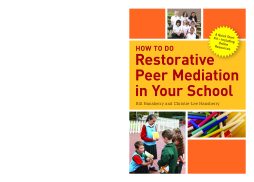
BOOK
How to Do Restorative Peer Mediation in Your School
Bill Hansberry | Christie-Lee Hansberry | Margaret Thorsborne
(2017)
Additional Information
Book Details
Abstract
Developed for schools exploring the use of restorative approaches to conflict resolution, this manual explains how to set up and run a restorative peer mediation programme, to provide students with the skills needed to nurture a climate of care and co-operation.
Peer mediation can help peers solve conflicts in the classroom and schoolyard, providing both peer mediators and the children they help with opportunities for responsibility, growth and learning, as well as freeing up time for teachers to focus on other priorities. The guide includes all the information you need on how restorative peer mediation works, and includes an easy to implement training programme with sample scripts, handouts and letter templates to train up peer mediators in your school.
With adapted materials for delivering training to children aged 10-16, this handbook is accompanied by downloadable and adaptable online materials to tailor training to specific settings.
The authors demonstrate on every page how much young people can learn from restorative peer mediation - including children who may themselves have been involved in difficult conflicts and who can bring special knowledge and skills to help others.
Helen Cowie, Emeritus Professor, Faculty of Health and Medical Sciences, University of Surrey
Bill and Christie-Lee Hansberry run an education consultancy (www.hansberryec.com.au). Bill is widely recognised for his knowledge about behaviour management, restorative justice and cultural renewal in educational settings.
This book has that most important of things: resources that will both support the busy staff member, and really engage students. An excellent addition to any school's toolkit on the journey to becoming a restorative community.
Chris Straker, Restorative Justice Council
Table of Contents
| Section Title | Page | Action | Price |
|---|---|---|---|
| How to Do Restorative Peer Mediation in Your School: A Quick Start Kit – Including Online Resources by Bill Hansberry and Christie-Lee Hansberry | 3 | ||
| 1. Introduction: Restorative Peer Mediators in Your School | 7 | ||
| Peer mediation | 7 | ||
| What’s in it for students? | 7 | ||
| What’s in it for an aspiring restorative school? | 9 | ||
| What’s in it for an established restorative school? | 9 | ||
| Which students make good RPMs? | 10 | ||
| Creating and maintaining a case for RPMs in your school | 10 | ||
| Links to curricula | 11 | ||
| The RPM selection process | 11 | ||
| Phase 1 training | 18 | ||
| Informing the community about the RPM program | 18 | ||
| Other RPM essentials | 21 | ||
| The RPM program implementation process in a nutshell | 22 | ||
| 2. Circles: How to Train Restorative Peer Mediators | 23 | ||
| Circles in the broader context | 23 | ||
| What does a circle look like? | 26 | ||
| Circle activities used in RPM training | 27 | ||
| Is circle training for RPM teachers necessary? | 29 | ||
| 3. Phase 1 Training Day | 31 | ||
| Suggested timetable for the training day | 32 | ||
| Using circles to make your RPMs into a team | 33 | ||
| Circle rules | 33 | ||
| Pass the smile | 34 | ||
| Warm-up | 34 | ||
| Mix-up and pair share | 36 | ||
| Pair share | 38 | ||
| Change places | 40 | ||
| Pair share and feedback | 41 | ||
| Practice time | 42 | ||
| Change places and pair share and feedback | 44 | ||
| Materials needed | 46 | ||
| Mix-up activity to create pairs | 46 | ||
| Change places | 49 | ||
| Pair share: Lance’s needs | 49 | ||
| Go-around: Lance’s needs | 50 | ||
| Pair share: Pete’s needs | 51 | ||
| Go-around: Pete’s needs | 51 | ||
| Identifying a commonality of needs | 52 | ||
| Pass the main idea | 53 | ||
| Alternative story – Go away, Jessica | 54 | ||
| Alternative story – The Basketball Story | 55 | ||
| Story: The Six Blind Men and the Elephant | 58 | ||
| Circle brainstorm/Ball throw | 59 | ||
| Play ‘what if’ | 60 | ||
| Modelling the Restorative Process for work with younger students | 61 | ||
| Getting kids ready to do restorative work | 61 | ||
| Building empathy | 61 | ||
| Silent statements | 65 | ||
| Modelling the Restorative Process for work with older students | 66 | ||
| Silent statements | 69 | ||
| Materials needed | 70 | ||
| Questions for the RPMs | 73 | ||
| Blank Page |
